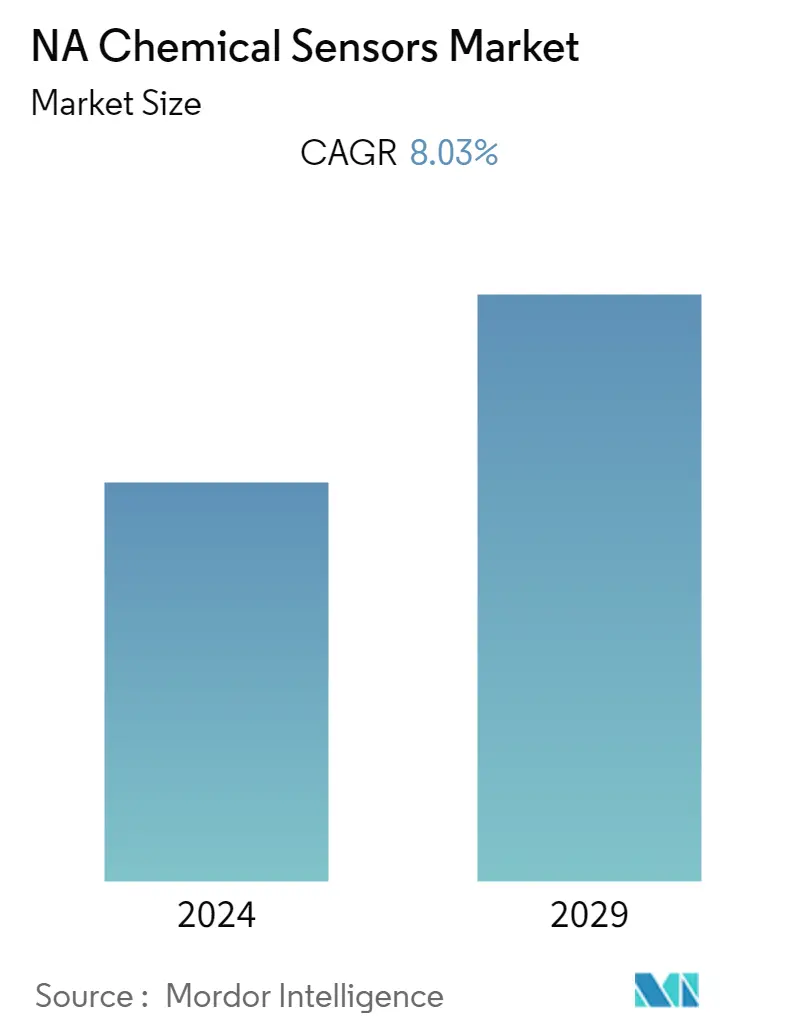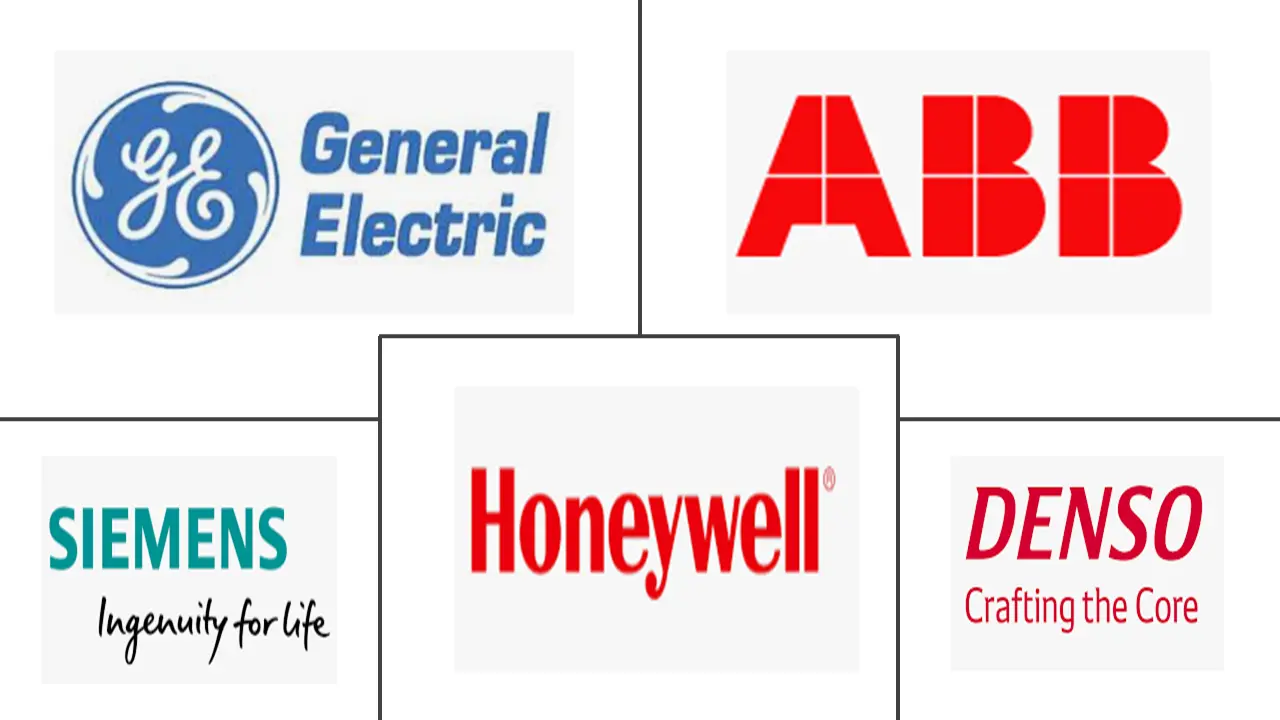Market Size of NA Chemical Sensors Industry

| Study Period | 2019 - 2029 |
| Base Year For Estimation | 2023 |
| Forecast Data Period | 2024 - 2029 |
| Historical Data Period | 2019 - 2022 |
| CAGR | 8.03 % |
| Market Concentration | Medium |
Major Players
*Disclaimer: Major Players sorted in no particular order |
North America Chemical Sensors Market Analysis
North America Chemical Sensors Market is expected to grow at a CAGR of 8.03% during the forecast period 2021-2026. In the chemical sensors market, North America has the greatest share. Advances will be fueled by a prolonged recovery in light vehicle manufacturing, as well as growing usage of advanced, higher cost universal exhaust gas oxygen sensors to increase vehicle fuel economy and performance. Increased demand for medicinal chemical sensors will also help the industry grow.
- The capacity of chemical sensors to analyze the chemical composition of various materials is driving their adoption. Chemical sensing arrays and higher-order orthogonal sensors are two major industry developments. Chemical sensors are projected to expand in popularity due to their low cost and portability.
- Aside from environmental concerns, the use of chemical sensors for analytes in chemical industrial processes is gaining traction. Sensors are being used as advanced tools in the defense sector, research labs, and healthcare operations, which is driving the market.
- The rising population and growing medical concerns are expected to result in a significant increase in the use of these sensors to heal illnesses. This will increase demand for sensors used in a variety of clinical applications, such as blood glucose monitoring, and will aid in the development of pharmaceutical applications.
- The COVID-19 epidemic has slowed the growth of several sectors, including automobiles, oil and gas, and others. Chemical-based sensors are most often used in the oil and gas sector. Many existing and planned projects across the oil and gas sector are encountering issues in terms of project planning and execution as a result of the COVID-19 epidemic, leading to a diminished contribution of chemical-based sensors.
North America Chemical Sensors Industry Segmentation
Chemical sensors are devices that convert chemical data into a signal that can be analyzed. These devices are employed in a variety of sectors to sense and detect factors, including medical diagnosis and treatment, the oil and gas sector, precision engineering, and so on.
| By Product Type | |
| Electrochemical | |
| Optical | |
| Pallister/Catalytic Bead | |
| Other Product Types |
| By Application | |
| Medical | |
| Oil and Gas | |
| Environmental Monitoring | |
| Automotive | |
| Industrial | |
| Others |
| By Country | |
| United States | |
| Canada | |
| Mexico | |
| Rest of North America |
NA Chemical Sensors Market Size Summary
The North America Chemical Sensors Market is experiencing significant growth, driven by advancements in various sectors such as automotive, healthcare, and industrial processes. The market's expansion is largely attributed to the increasing demand for chemical sensors that can analyze the chemical composition of materials, offering benefits like low cost and portability. In the automotive industry, the recovery in light vehicle manufacturing and the adoption of advanced exhaust gas sensors are enhancing vehicle performance and fuel economy. Additionally, the healthcare sector is witnessing a rise in the use of medicinal chemical sensors, further propelling market growth. Despite challenges posed by the COVID-19 pandemic, which affected sectors like oil and gas, the market continues to thrive due to its diverse applications in defense, research, and environmental monitoring.
The market is characterized by a partially fragmented landscape with key players such as Honeywell International Inc., Denso Corporation, ABB Ltd., Siemens AG, and General Electric Co. These companies are actively involved in strategic initiatives to enhance their product offerings and expand their market presence. Innovations like the Compact Vapor Chemical Agent Detector and the development of new generations of exhaust gas sensors are indicative of the ongoing advancements in the field. The automotive industry's strong consumer demand and the need for high-sensitivity sensors to manage combustion engines are also contributing to the market's growth. As stricter pollution laws and on-board diagnostics become more prevalent, the demand for advanced chemical sensors is expected to rise, further driving the market's expansion in North America.
NA Chemical Sensors Market Size - Table of Contents
-
1. MARKET INSIGHTS
-
1.1 Market Overview
-
1.2 Value Chain / Supply Chain Analysis
-
1.3 Industry Attractiveness - Porter's Five Force Analysis
-
1.3.1 Threat of New Entrants
-
1.3.2 Bargaining Power of Buyers
-
1.3.3 Bargaining Power of Suppliers
-
1.3.4 Threat of Substitute Products
-
1.3.5 Intensity of Competitive Rivalry
-
-
1.4 Assessment of COVID-19 Impact on the Industry
-
-
2. MARKET SEGMENTATION
-
2.1 By Product Type
-
2.1.1 Electrochemical
-
2.1.2 Optical
-
2.1.3 Pallister/Catalytic Bead
-
2.1.4 Other Product Types
-
-
2.2 By Application
-
2.2.1 Medical
-
2.2.2 Oil and Gas
-
2.2.3 Environmental Monitoring
-
2.2.4 Automotive
-
2.2.5 Industrial
-
2.2.6 Others
-
-
2.3 By Country
-
2.3.1 United States
-
2.3.2 Canada
-
2.3.3 Mexico
-
2.3.4 Rest of North America
-
-
NA Chemical Sensors Market Size FAQs
What is the current NA Chemical Sensors Market size?
The NA Chemical Sensors Market is projected to register a CAGR of 8.03% during the forecast period (2024-2029)
Who are the key players in NA Chemical Sensors Market?
Honeywell International Inc., Denso Corporation, ABB Ltd., Siemens AG and General Electric Co. are the major companies operating in the NA Chemical Sensors Market.

